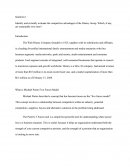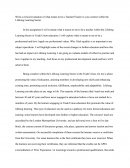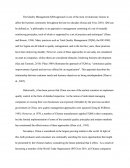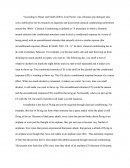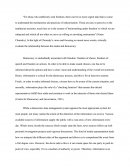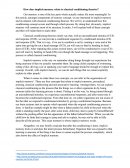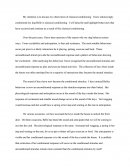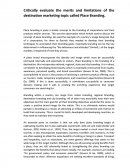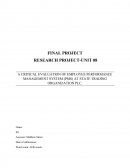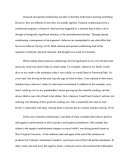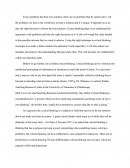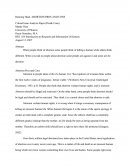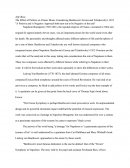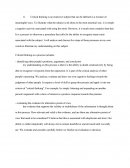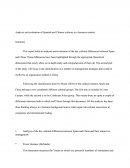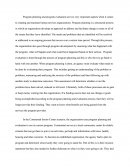Critical Evaluation Task Classical Conditioning essays
358 Critical Evaluation Task Classical Conditioning Essays: 1 - 25
-
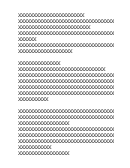
Classical Conditioning
Classical conditioning, discovered in the late nineteenth century, is the ability to associate a relationship between two different stimuli. As Pavlov was investigating the digestive system of dogs, he discovered that saliva was produced as the dogs where presented with food. He then found that the dogs produced the same response when a chime was sounded before food was presented, even if the food was not produced on a particular occasion. This shows that the
Rating:Essay Length: 1,225 Words / 5 PagesSubmitted: May 2, 2011 -
Identify and Critically Evaluate the Competitive Advantages of the Disney Group. Which, If Any, Are Sustainable over Time?
Question 1 Identify and critically evaluate the competitive advantages of the Disney Group. Which, if any, are sustainable over time? Introduction The Walt Disney Company founded in 1923, together with its subsidiaries and affiliates, is a leading diversified international family entertainment and media enterprise with four business segments: media networks, parks and resorts, studio entertainment and consumer products. Each segment consists of integrated, well-connected businesses that operate in concert to maximize exposure and growth worldwide.
Rating:Essay Length: 1,211 Words / 5 PagesSubmitted: July 9, 2011 -
Write a Critical Evaluation of What Means to Be a Teacher/trainer in Your Context Within the Lifelong Learning Sector
Write a critical evaluation of what means to be a Teacher/Trainer in your context within the Lifelong Learning Sector. In this assignment I will evaluate what it means to me to be a teacher within the Lifelong Learning Sector in Trade Union education. I will explore what it means to me to be a professional and how I apply my professional values. Why I feel equality is so important in my subject specialism. I will
Rating:Essay Length: 1,923 Words / 8 PagesSubmitted: July 13, 2011 -
Critical Evaluation of Quality Management Approaches in Chinese Businesses
The Quality Management (QM) approach is one of the most revolutionary factors to affect the business community throughout the last two decades (Sousa and Voss, 2001). QM can be defined as, "a philosophy or an approach to management consisting of a set of mutually reinforcing principles, each of which is supported by a set of practices and techniques" (Dean and Bowen, 1994). Many practices such as Total Quality Management (TQM), the ISO 9000, and Six
Rating:Essay Length: 488 Words / 2 PagesSubmitted: September 24, 2011 -
Classical Conditioning
"According to Passer and Smith (2001), Ivan Pavlov was a Russian psychologist who won a noble prize for his research on digestion and discovered classical conditioning somewhere around the 1860s." Classical Conditioning is defined as "A procedure in which a formerly neutral stimulus (the conditioned stimulus) come to elicit a conditioned response by virture of being paired with an unconditioned stimulus that naturally elicits a similar reponse (the unconditioned response) (Passer & Smith, 2001, Ch.
Rating:Essay Length: 483 Words / 2 PagesSubmitted: March 26, 2012 -
Critically Evaluate the Relationship Between the Media and Democracy
"For those who stubbornly seek freedom, there can be no more urgent task than to come to understand the mechanisms and practices of indoctrination. These are easy to perceive in the totalitarian societies, much less so in the system of 'brainwashing under freedom' to which we are subjected and which all too often we serve as willing or unwitting instruments" (Noam Chomsky). In the light of Chomsky's views and focusing on recent news events, critically
Rating:Essay Length: 1,847 Words / 8 PagesSubmitted: August 13, 2012 -
Critically Evaluate Maslow's Hierarchy of Needs as Way of Understanding Employee Motivation in Contemporary Chinese Business
Critically evaluate Maslow's hierarchy of needs as way of understanding employee motivation in contemporary Chinese business In the past, employees were just regarded as a tool to improve the productivity. Then Hawthorne Studies conducted by Elton Mayo indicated that not only can salary motivate the employee but also the attitudes of employee, which changed this point of view above (Lindner, 1998). Maslow's hierarchy of needs theory, which divided the needs of people into five levels,
Rating:Essay Length: 1,254 Words / 6 PagesSubmitted: October 23, 2012 -
Critically Evaluate Maslow's Hierarchy of Needs as Way of Understanding Employee Motivation in Contemporary Chinese Business
After three decades of spectacular growth, the People's Republic of China, the world's fastest-growing primary economy, has just past Japan and became the second-largest economy in the world in 2010. However, problems associated with human resources management appear in China as the needs of employee and the ways to motivate them are not well analyzed. As one of the predominant and controversial motivation theories, Maslow's hierarchy of needs illustrates personal needs in five layers. Maslow
Rating:Essay Length: 1,080 Words / 5 PagesSubmitted: November 22, 2012 -
Critically Evaluate Maslow's Hierarchy of Needs as a Way of Understanding Employee Motivation in Contemporary Chinese Business
Before Maslow's hierarchy of needs, managers perform Taylor's management system, which is a kind of management defined as employees' pay is the most important. It is believed that Maslow's theory is more advanced than Taylor's, so Maslow's theory has been widely accepted in management. According to this theory, people's behaviors are driven by motivation, which is variable and presents as a hierarchy (Maslow, 1943). Though it is adapted in management around the world, there still
Rating:Essay Length: 996 Words / 4 PagesSubmitted: November 23, 2012 -
Critically Evaluate Maslow's Hierarchy of Needs as Way of Understanding Employees' Motivation in Contemporary Chinese Business
As the globalization is stepping up, Chinese business is facing all kinds of opportunities. However, at the same time, challenges also appear for Chinese employers to cope with. Giving the fact that a suitable method of administration can bring a large profit, it is important for Chinese employers to learn to motivate their employees so that they can acquire higher revenue. Although as some economists argued that there is not any clear evidence to support
Rating:Essay Length: 1,271 Words / 6 PagesSubmitted: November 24, 2012 -
How Does Implicit Memory Relate to Classical Conditioning Theories?
How does implicit memory relate to classical conditioning theories? Our memory is one of the key parts which actually makes life more meaningful. In this article, amongst components of memory concept, we are interested in implicit memory and its relation with classical conditioning theories. We will try to understand how this conditioning concept occurs and through which process. By doing that, obviously, implicit memory will construct most of its structure. In order, I will explain
Rating:Essay Length: 542 Words / 3 PagesSubmitted: January 7, 2016 -
Classical Conditioning
My intention is to discuss my observation of classical conditioning. I have unknowingly conditioned my dog Belle in classical conditioning. I will describe and highlight behaviours that have occurred and continue as a result of this classical conditioning. Over the past years, I have been unaware of the reason why my dog behaves certain ways. From excitability and anticipation, to fear and resistance. The most notable behaviours occur just prior to a likely interaction be
Rating:Essay Length: 431 Words / 2 PagesSubmitted: July 20, 2016 -
Critically Evaluate the Merits and Limitations of the Destination Marketing Topic Called Place Branding
Critically evaluate the merits and limitations of the destination marketing topic called Place Branding. Place branding is quite a similar concept to the branding of corporations and their products and/or services. This was the observation which Anholt used to discuss the concept of place branding. He used the example of a country’s image being like that of a corporation; for them to flourish they needed to develop their branding techniques to accomplish their branding goals.
Rating:Essay Length: 2,341 Words / 10 PagesSubmitted: March 16, 2017 -
Self-Efficacy Critical Evaluation
PSY4111 Victoria Groom Critical Evaluation Task 2 Critical Evaluation Task 2 Self-efficacy is defined as a person’s beliefs about their own personal capabilities to produce designated levels of performance that exercise influence over events in their lives (Bandura, 1997). There are four influences on a person’s self-efficacy which are; mastery experiences, vicarious experiences, verbal persuasion and physiological states (Pajares, 2017). I believe I have a high level of self-efficacy toward the completion of my degree.
Rating:Essay Length: 541 Words / 3 PagesSubmitted: October 3, 2017 -
A Critical Evaluation of Employee Performance Management System (pms) at State Trading Organization Plc.
UNIT 08 | RESEARCH PROJECT FINAL PROJECT RESEARCH PROJECT-UNIT 08 A CRITICAL EVALUATION OF EMPLOYEE PERFORMANCE MANAGEMENT SYSTEM (PMS) AT STATE TRADING ORGANIZATION PLC. Name: ID: Assessor: Matthew Street Date of submission: Word count: 4390 words Table of Contents Abstract 5 CHAPTER ONE 5 1.0 Introduction 5 1.1 Background 5 1.2 Research problem 5 2.0 Focus of the study 6 2.1 Purpose of the research 6 2.2 Research question 6 2.3 Significance of the research
Rating:Essay Length: 5,404 Words / 22 PagesSubmitted: December 10, 2017 -
Classical and Operant Conditioning
Classical and operant conditioning are alike in that they both lead to learning something. However, they are different in how they are actually applied. Classical conditioning elicits a conditioned response--a behavior--that has been triggered by a stimulus that is able to do so through a biologically significant stimulus, or the unconditioned stimulus. Through operant conditioning, consequences of an organism’s behavior are manipulated to see what effect that has on its behavior (Gerrig, 2013). Both classical
Rating:Essay Length: 439 Words / 2 PagesSubmitted: November 3, 2015 -
Evaluate the Core Critical Thinking Skills
Every problems has their own solution, there are no problems that be cannot solve. All the problems we face in the world have at least a solution and it’s unique. It depends on us to take the right decision to choose the best solution. Critical thinking helps us to understand the argument or the problems and take the right decisions on it. It also will weigh the value needed in the possible outcome that we
Rating:Essay Length: 1,188 Words / 5 PagesSubmitted: December 19, 2015 -
Pros and Cons of Abortion - Critical Issue Analysis Paper
Running Head: ABORTION PROS AND CONS Critical Issue Analysis Paper (Pros& Cons) Mandy Diaz University of Phoenix Oscar Gonzalez, M.A. RES 110/ Introduction to Research and Information Utilization August 13, 2007 Abstract When people think of abortion some people think of killing a human while others think different. When you talk to people about abortion some people are against it and some are for abortion. Abortion Pros and Cons Abortion to people takes a life
Rating:Essay Length: 7,306 Words / 30 PagesSubmitted: December 20, 2010 -
The Effect of Politics on Classic Music Considering Beethoven's Eroica and Tchaikovsky's 1812
Alp Okcu The Effect of Politics on Classic Music Considering Beethoven's Eroica and Tchaikovsky's 1812 "A Positive and A Negative Approach both turn out to be Negative in the end" Napoleon Bonaparte (1769-1821), the reputed emperor of France, coroneted in 1804 and reigned for approximately eleven years, was an important person for the world scene even after his death. His personality and thoughts affected many different spheres of life and the sphere of art is
Rating:Essay Length: 2,043 Words / 9 PagesSubmitted: December 26, 2010 -
Critical Thinking and Its Processes
1) Critical thinking is an extensive subject that can be defined in a mixture of meaningful ways. To illustrate what the subject is all about in the most essential way; it is simply a cognitive activity associated with using the mind. However, it is much more complex than that. It is a process or otherwise a procedure that calls for the ability to recognize many traits associated with the subject. I will analyze and discuss
Rating:Essay Length: 277 Words / 2 PagesSubmitted: February 14, 2011 -
Critical Thinking
Critical Thinking Critical thinking can mean different things to different people. Many people have developed new definitions of critical thinking. One of the definitions is "Critical thinking is the identification and evaluation of evidence to guide decision making." (2005). One other definition of critical thinking is "critical thinking is the art of thinking about thinking while thinking in order to make thinking better. It involves three interwoven phases: it analyzes thinking, it evaluates thinking, it
Rating:Essay Length: 758 Words / 4 PagesSubmitted: March 1, 2011 -
Analysis and Evaluation of Spanish and Chinese Cultures in a Business Context
Analysis and evaluation of Spanish and Chinese cultures in a business context. Summary This report holds an analysis and evaluation of the key cultural differences between Spain and China. These differences have been highlighted through the appropriate theoretical dimensions that surely allow an in depth study and comprehension of them all. The second part of the study will focus in the identification of a number of management strategies that could be useful for an
Rating:Essay Length: 1,961 Words / 8 PagesSubmitted: March 1, 2011 -
Com 200 - Critical Thinking
COM 200 September 10, 2010 Critical Thinking Essay, Ch. 2 Question: Discuss how you determine the credibility of sources that you use to gather news. Do you trust instant messages, text messages, and twitters more than new accounts? Describe how you learned about a recent news event that interests you, and discuss why you trusted the source of that news. In today's world, we highly depend on others for news. Whether it's about politics, education,
Rating:Essay Length: 705 Words / 3 PagesSubmitted: March 4, 2011 -
Program Planning and Program Evaluation
Program planning and program evaluation are two very important aspects when it comes to creating and maintain human services organizations. Program planning is a structured process in which an organization develops an approach to address and facilitate change in some or all of the issues that they have identified. The needs and problems that are identified will be resolved or addressed in an ongoing process that occurs over a certain time period. Through this process,
Rating:Essay Length: 731 Words / 3 PagesSubmitted: March 22, 2011 -
Bsc Evaluation - Chemical Bank
Chemical Bank Q1 Chemical's Retail Bank competes in a marketplace characterized by intense pricing competition, and outflow of deposits to mutual funds, rapidly evolving technology, and increased customer demand for value. In addition to those factors, the underlying growth in core expenses, such as occupancy, salaries and benefits, also help causes a real profitability squeeze for the Retail Bank. The company needs to change its strategy to a market-focused organization that focuses on targeted customer
Rating:Essay Length: 677 Words / 3 PagesSubmitted: April 14, 2011
